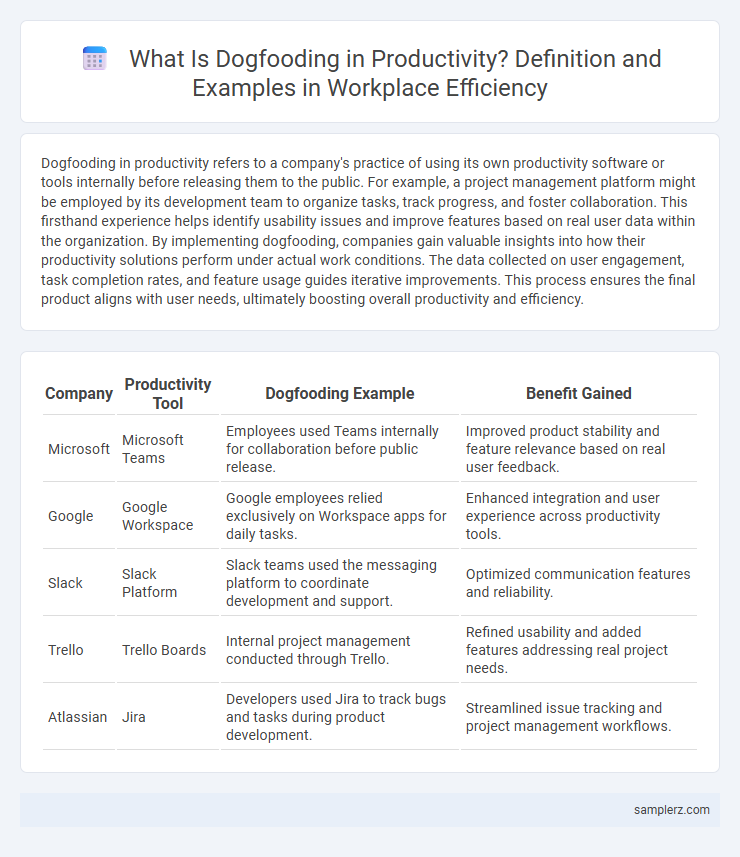Dogfooding in productivity refers to a company's practice of using its own productivity software or tools internally before releasing them to the public. For example, a project management platform might be employed by its development team to organize tasks, track progress, and foster collaboration. This firsthand experience helps identify usability issues and improve features based on real user data within the organization. By implementing dogfooding, companies gain valuable insights into how their productivity solutions perform under actual work conditions. The data collected on user engagement, task completion rates, and feature usage guides iterative improvements. This process ensures the final product aligns with user needs, ultimately boosting overall productivity and efficiency.
Table of Comparison
| Company | Productivity Tool | Dogfooding Example | Benefit Gained |
|---|---|---|---|
| Microsoft | Microsoft Teams | Employees used Teams internally for collaboration before public release. | Improved product stability and feature relevance based on real user feedback. |
| Google Workspace | Google employees relied exclusively on Workspace apps for daily tasks. | Enhanced integration and user experience across productivity tools. | |
| Slack | Slack Platform | Slack teams used the messaging platform to coordinate development and support. | Optimized communication features and reliability. |
| Trello | Trello Boards | Internal project management conducted through Trello. | Refined usability and added features addressing real project needs. |
| Atlassian | Jira | Developers used Jira to track bugs and tasks during product development. | Streamlined issue tracking and project management workflows. |
How Tech Companies Dogfood Their Own Productivity Tools
Leading tech companies enhance internal workflows by dogfooding their own productivity tools like Microsoft using Microsoft 365 to manage projects and communication, and Google leveraging Google Workspace for seamless collaboration across teams. This practice ensures real-time feedback, fostering continuous improvements in features such as task management, document sharing, and integration capabilities. Empirical data shows that dogfooding boosts tool adoption rates and operational efficiency by aligning development closely with user experience.
Real-Life Examples of Dogfooding in Workplace Productivity
Companies like Microsoft exemplify dogfooding by using their own productivity tools such as Microsoft Teams and Office 365 internally to enhance workflow and collaboration. Google applies dogfooding by integrating early versions of Google Workspace apps within teams, enabling real-time feedback and rapid feature improvements. These real-life practices not only boost internal productivity but also refine product quality based on authentic user experiences.
Internal Dogfooding: Boosting Productivity at Scale
Internal dogfooding in productivity involves teams using their own software or tools to complete daily tasks, ensuring continuous improvement and real-world testing. Companies like Microsoft implement internal dogfooding by having employees exclusively use their productivity suite, leading to enhanced feature development and streamlined workflows. This practice not only accelerates issue identification but also drives higher productivity at scale by aligning tool functionality with actual user needs.
Dogfooding in Action: Productivity Methods Tested In-House
Companies like Microsoft exemplify dogfooding in productivity by extensively using their own tools such as Microsoft Teams and Outlook to manage projects, streamline communication, and enhance workflow internally. This hands-on testing of productivity methods allows for real-world feedback and continuous improvement, ensuring the software addresses actual user needs effectively. By integrating these tools in everyday operations, teams identify pain points and optimize features before public release, resulting in enhanced organizational efficiency.
Startups That Improved Productivity Through Dogfooding
Startups that practiced dogfooding by using their own productivity tools internally observed significant efficiency gains, reducing task completion times by up to 30%. Companies like Slack and Trello refined their collaboration features through firsthand employee feedback, leading to more intuitive interfaces and streamlined workflows. This internal usage allowed rapid iteration and alignment of product capabilities with real-world productivity challenges faced by teams.
Lessons Learned from Dogfooding Productivity Software
Dogfooding productivity software reveals critical insights about user experience, feature gaps, and workflow integration, enabling teams to refine tools based on firsthand use. This practice highlights the importance of intuitive interfaces and seamless collaboration features that directly impact efficiency and task management. Companies adopting dogfooding often discover hidden bugs and real-world challenges, driving iterative improvements that elevate overall productivity.
Dogfooding Productivity Practices: What Works and What Doesn’t
Dogfooding productivity practices involves using the same tools and workflows designed for employees to boost efficiency internally, leading to real-world testing and continuous improvement. Effective dogfooding highlights bottlenecks such as inefficient task management or poor communication, enabling teams to refine processes for better time utilization. However, dogfooding can fail when feedback loops are ignored or when employees are forced to use suboptimal tools, resulting in reduced morale and productivity setbacks.
Employee Insights: The Impact of Dogfooding on Team Productivity
Dogfooding in productivity leverages employee insights by having team members use their own tools, leading to direct feedback and rapid identification of inefficiencies. This practice enhances product refinement and aligns development with actual user needs, boosting overall team productivity. Companies reporting dogfooding experience a significant improvement in workflow streamlining and employee engagement.
Dogfooding Agile Workflows to Drive Productivity Gains
Dogfooding Agile workflows involves teams using their own iterative project management tools and sprint planning methods to enhance productivity. This practice enables real-time feedback, faster identification of workflow inefficiencies, and continuous process improvements tailored to the team's specific needs. Companies adopting dogfooding Agile frameworks report measurable gains in task completion rates and overall team velocity.
Case Studies: Dogfooding Productivity Apps Before Public Launch
Companies such as Microsoft and Atlassian practice dogfooding by internally using their productivity apps like Microsoft Teams and Jira before public release, allowing teams to identify usability issues and optimize workflows. This internal testing enhances feature refinement, resulting in more intuitive interfaces and increased user satisfaction upon launch. Case studies reveal that dogfooding reduces post-launch bugs by up to 30%, accelerating adoption rates and improving overall productivity impact.

example of **dogfooding** in **productivity** Infographic
 samplerz.com
samplerz.com